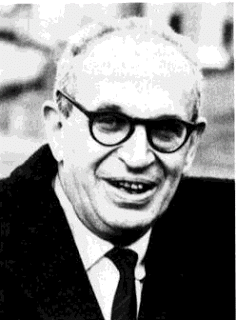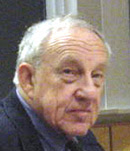I like this piece in The Economist on Facebook’s audacious new advertising plan — and not just because it quotes me. Rather, the writer took seriously one of my long “there’s nothing new under the sun” disquisitions that most of my friends and colleagues ignore. In this case, it’s that today’s social-networking and -marketing phenomenon is not at all novel. Rather, it derives from research done by two of the 20th Century’s leading media theorists: Paul Lazarsfeld and Elihu Katz.
Lazarsfeld (pictured at left) was a famed emigre sociologist from Germany and Katz his student at Columbia University when they did the work that led to their pioneering 1955 book, Personal Influence. The book challenged a reigning theory of media influence: that mass media “work” directly, by injecting ideas into the minds of relatively isolated people. That notion was — and still is — almost reflexively accepted by anyone who has worked in or around media, marketing, and advertising. “Our programs and ads,” we believe, “forge peoples’ opinions.” It is a tenet deeply-held by copywriters and anchormen alike.
at Columbia University when they did the work that led to their pioneering 1955 book, Personal Influence. The book challenged a reigning theory of media influence: that mass media “work” directly, by injecting ideas into the minds of relatively isolated people. That notion was — and still is — almost reflexively accepted by anyone who has worked in or around media, marketing, and advertising. “Our programs and ads,” we believe, “forge peoples’ opinions.” It is a tenet deeply-held by copywriters and anchormen alike.
Lazarsfeld and Katz showed that this “Magic Bullet Theory” was inaccurate. An earlier Lazarsfeld study had shown that only some 5 percent of Presidential voters had their opinions shaped directly by media messages. Together, the two scholars showed that media work more indirectly, through social influence. They identified a “two-step flow,” by which media messages reinforced what people heard from others in one or another of their communities. These social influencers are, in the Lazarsfeld and Katz formulation, “opinion leaders.”
Many of the assumptions that still drive modern marketing mavens were overturned 50 years ago by the two professors. Receiving a message does not imply responding to it, they showed. Moreover, top-down influence generally is fairly benign. People belong to numerous communities, and are influenced in different things by different opinion leaders. But just try telling that to a high-priced creative with a killer reel. It seems the world rediscovers personal influence every few years or so — in the form of “word of mouth marketing,” “brand advocacy,” “guerrilla marketing,” and “brand zealotry” — only to forget it the next time a fabulous, award-winning ad campaign or a depressing, mud-slinging political campaign comes slamming down the airwaves.
 The Facebook notion of defining the world’s “social graph” — “the network of connections and relationships between people on the service,” in Facebook founder Mark Zuckerberg’s phrase — and deploying it in the service of marketers is the latest marketing spin around the half-century-old work of Lazarsfeld and Katz. (That’s Katz at left.) What’s changed, of course, is that when Lazarsfeld and Katz were writing, the only scalable communications tools available were mass media, notably the new phenomenon of television. Today, social networking sites of enormous reach — larger than television’s, because they have instantaneous global scope — allow opinion leaders to shape attitudes in communities far and wide… and near and narrow. That’s the promise underlying Facebook’s notion to “marry an ad message to a user-initiated endorsement of a product or service,” as Ad Age put it.
The Facebook notion of defining the world’s “social graph” — “the network of connections and relationships between people on the service,” in Facebook founder Mark Zuckerberg’s phrase — and deploying it in the service of marketers is the latest marketing spin around the half-century-old work of Lazarsfeld and Katz. (That’s Katz at left.) What’s changed, of course, is that when Lazarsfeld and Katz were writing, the only scalable communications tools available were mass media, notably the new phenomenon of television. Today, social networking sites of enormous reach — larger than television’s, because they have instantaneous global scope — allow opinion leaders to shape attitudes in communities far and wide… and near and narrow. That’s the promise underlying Facebook’s notion to “marry an ad message to a user-initiated endorsement of a product or service,” as Ad Age put it.
But Lazarsfeld and Katz bear re-reading, and not just for Silicon Alley cocktail party one-upsmanship. The importance of personal mediation means that television, radio, and print communications have always been filtered in ways their creators could not necessarily predict. The old saw that “nothing will kill a bad product faster than a great ad” is an example of this, although few practitioners recognize it. Today, with the Internet allowing all manner of influencers to wield their opinions in any way they choose, the relationship between the constructed campaign and its eventual effects is even more unpredictable.
In fact, it will take a supremely clever ad agencies and consumer marketers with strong stomachs to test themselves against the backlashes that seem all but inevitable. For if there’s anything that might unravel your personal social graph, it’ll be too many personal ads and endorsements tearing through it. The results might look like a book written by Dale Carnegie’s evil twin: How to Lose Friends and Not Influence People.